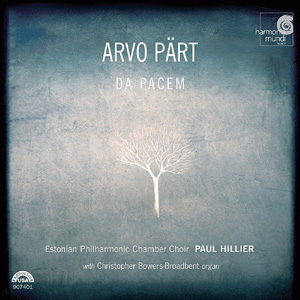 The music of Arvo Pärt, one of the best known contemporary composers, is something I’ve always found attractive. From my first recording of Passio, which was, believe it or not, my beach music for a whole summer way back when, I’ve been an enthusiastic follower of his works. Like many contemporary composers of art music, particularly, it seems, Europeans, Pärt has produced a great deal of sacred music. The major works include Passio, Litany, the Kanon Pokajanen, and a haunting Stabat Mater. There are also a number of shorter works, quite often in the form of psalms set to music, as in the “Two Slavonic Psalms” premiered on this recording, which is itself a collection of some of his shorter sacred works.
The music of Arvo Pärt, one of the best known contemporary composers, is something I’ve always found attractive. From my first recording of Passio, which was, believe it or not, my beach music for a whole summer way back when, I’ve been an enthusiastic follower of his works. Like many contemporary composers of art music, particularly, it seems, Europeans, Pärt has produced a great deal of sacred music. The major works include Passio, Litany, the Kanon Pokajanen, and a haunting Stabat Mater. There are also a number of shorter works, quite often in the form of psalms set to music, as in the “Two Slavonic Psalms” premiered on this recording, which is itself a collection of some of his shorter sacred works.
Pärt has, since the late 1970s, worked largely in triads, essentially the same as Debussy’s “tone blocks,” which gives his music a strong likeness to early Church music. Indeed, he has deliberately used the modes and structures of medieval sacred music, although his vocabulary remains contemporary. (And it’s worth wondering if “contemporary” in this sense really denotes anything new.) This is the third of a series of surveys of Pärt’s shorter choral works by Paul Hillier, and if anything illustrates the composer’s strong roots in early music, it is Hillier’s interest and sympathy to Pärt’s works. Hillier, after all, made his reputation as an interpreter of medieval music.
Another aspect of Pärt’s work that needs attention: the composer has stated quite plainly that the language of the text in essence shapes the music he composes to accompany it, and in this case “accompany” is a weak term: read rather “illustrate,” “expand upon,” “illuminate.” Hillier, in his comments, discusses Pärt’s “rhetorical position” as it relates to the way he uses a text. Pärt composes for deeper meanings, as often working against the surface of the text as with it, and while he does this, he allows the sounds and structures of the language itself to shape the patterns in his compositions. Thus, the Passio, with a Latin text, has quite a different character than the Kanon Pokajanen, which uses an ancient text in Church Slavonic, and both differ from Litany, with a text in English. One thing that remains constant, however, is the unearthly quality of the music, a characteristic it shares with medieval plainsong and early polyphony. Since the majority of Pärt’s sacred works are a capella, the similarity to early music is even closer, particularly the music of fourteenth-century England.
There is also an immense potential for drama in the music, amply illustrated by these works, which display a range of Pärt’s concerns from the late 1970s to 2004. (A note about dates: Arvo Pärt has a tendency to play with “finished” compositions, rearranging, rethinking, and sometimes rescoring them, so that something like “An den Wassern zu Babel” is dated 1976/1984/1991. That’s a typical thing for him to do.) While Pärt’s music is often understated, he is also capable of bringing out a “wall of sound” to provide an almost overwhelming instensity to the experience.
Hillier’s sense of the meaning of this music is remarkable. He has a facility for finding not only the understated subtleties but also the broad strokes and balancing them effortlessly. The Estonian Philharmonic Chamber Choir has long experience with Pärt’s music, and Hillier manages to bring out a sound at once rarified and substantial.
The one fault with this recording, and sometimes with Pärt’s music as a whole, is that there is insufficient variation from work to work to give a sense of separate identities. Da Pacem can easily be taken as one work in multiple movements, unless one is prepared to listen extremely closely for the subtle variations in mood that do happen. This is, however, an excellent introduction to the music of an important contemporary composer, performed with sensitivity and sympathy by one of the foremost interpreters of Pärt’s music.
(Harmonia Mundi, 2006)
